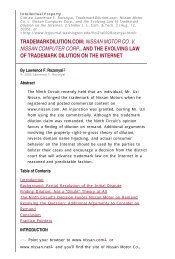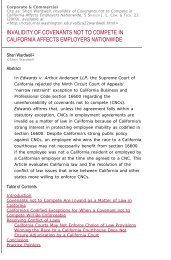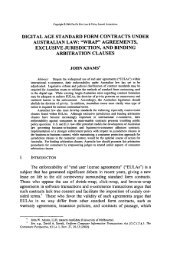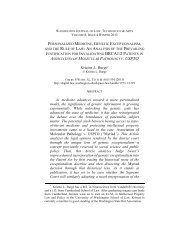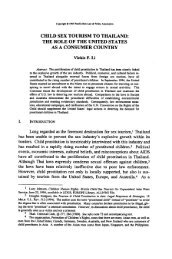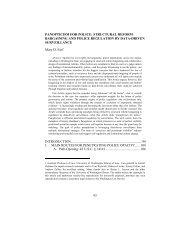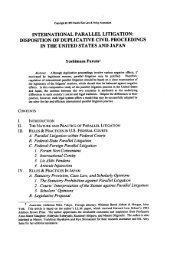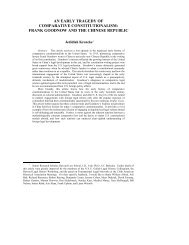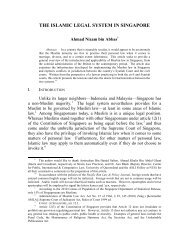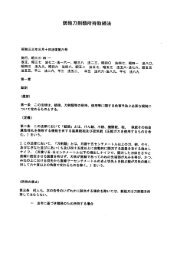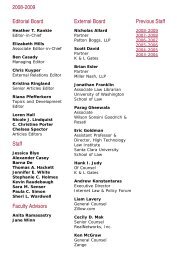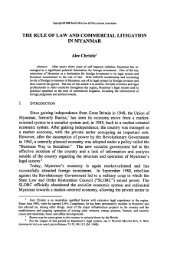Regulations on Bid Rigging in Japan, the United States and Europe
Regulations on Bid Rigging in Japan, the United States and Europe
Regulations on Bid Rigging in Japan, the United States and Europe
You also want an ePaper? Increase the reach of your titles
YUMPU automatically turns print PDFs into web optimized ePapers that Google loves.
Copyright 0 1995 Pacific Rim Law & Policy Associati<strong>on</strong>REGULATIONS ON BID RIGGING IN JAPAN,THE UNITED STATES AND EUROPENaoaki OkatanitAbstract. This article provides a comparative perspective <strong>on</strong> bid rigg<strong>in</strong>g <strong>in</strong> <strong>Japan</strong>,<strong>the</strong> <strong>United</strong> <strong>States</strong> <strong>and</strong> <strong>Europe</strong>. It emphasizes <strong>the</strong> differences <strong>in</strong> both <strong>in</strong>stituti<strong>on</strong>al structureas well as policy <strong>and</strong> bus<strong>in</strong>ess culture <strong>in</strong> <strong>the</strong> three jurisdicti<strong>on</strong>s, particularly <strong>in</strong> terms ofantitrust <strong>and</strong> crim<strong>in</strong>al law enforcement. It notes <strong>the</strong> greater tolerance of bid rigg<strong>in</strong>g <strong>in</strong><strong>Japan</strong> <strong>in</strong> <strong>the</strong> case of c<strong>on</strong>structi<strong>on</strong> c<strong>on</strong>tracts for public works.CONTENTSI. INTRODUCTIONII. BID RIGGING IN JAPANA. <str<strong>on</strong>g>Regulati<strong>on</strong>s</str<strong>on</strong>g> <strong>on</strong> <strong>Bid</strong> <strong>Rigg<strong>in</strong>g</strong> under <strong>the</strong> Antim<strong>on</strong>opoly Law1. Regulatory Measures by <strong>the</strong> FTC2. Damage Remedy SuitsB. Illegal <strong>Bid</strong> <strong>Rigg<strong>in</strong>g</strong> Under <strong>the</strong> Penal CodeC. O<strong>the</strong>r Issues1. Major C<strong>on</strong>structi<strong>on</strong> <strong>Bid</strong> <strong>Rigg<strong>in</strong>g</strong> Cases <strong>in</strong> <strong>Japan</strong>III. BID RIGGING IN THE UNITED STATES AND EUROPEA. The <strong>United</strong> <strong>States</strong>B. <strong>Europe</strong>IV.REVIEW OF JAPAN'S CONSTRUCTION INDUSTRYV. CONCLUSIONI. INTRODUCTIONIn <strong>Japan</strong>, <strong>the</strong> procedures used for government procurement <strong>and</strong> workc<strong>on</strong>tracts are set forth <strong>in</strong> article 29-3, article 29-5, <strong>and</strong> article 29-6 of <strong>the</strong>Accounts Law. 1 This law requires <strong>the</strong> determ<strong>in</strong>ati<strong>on</strong> of <strong>the</strong> c<strong>on</strong>tract<strong>in</strong>gparties at <strong>the</strong> c<strong>on</strong>clusi<strong>on</strong> of <strong>the</strong> bidd<strong>in</strong>g process. (In <strong>the</strong> case of local publict. Senior Research Associate, Corporate Communicati<strong>on</strong>s Research Bureau, Market DevelopmentDepartment, Mitsubishi Research Institute.I Kaikei h6 (Accounts Law), arts. 29-3, 29-5, 29-6, Law No. 35 of 1947 [here<strong>in</strong>after AccountsLaw].
PACIFIC RIM LAW & POLICY JOURNALVOL. 4 No. Iauthorities, article 234 of <strong>the</strong> Local Aut<strong>on</strong>omy Law 2 c<strong>on</strong>ta<strong>in</strong>s a similarprovisi<strong>on</strong>.) <strong>Bid</strong> rigg<strong>in</strong>g is a practice c<strong>on</strong>ducted am<strong>on</strong>g bidders dur<strong>in</strong>g <strong>the</strong>bidd<strong>in</strong>g process for public works c<strong>on</strong>tracts <strong>and</strong> o<strong>the</strong>r projects offered by <strong>the</strong>government <strong>and</strong> municipal offices. <strong>Bid</strong>ders collude <strong>and</strong> decide whichcompanies should get public works orders <strong>and</strong> <strong>the</strong> expected c<strong>on</strong>tract price.Each bidder <strong>the</strong>n bids <strong>in</strong> such a manner that <strong>the</strong> pre-determ<strong>in</strong>ed c<strong>on</strong>tractw<strong>in</strong>ner <strong>and</strong> c<strong>on</strong>tract price become, respectively, <strong>the</strong> successful bidder <strong>and</strong><strong>the</strong> successful bid price. There are two methods of bid rigg<strong>in</strong>g. In <strong>the</strong> firstmethod, a w<strong>in</strong>n<strong>in</strong>g bid is determ<strong>in</strong>ed for each c<strong>on</strong>tract. In <strong>the</strong> sec<strong>on</strong>dmethod, c<strong>on</strong>structi<strong>on</strong> firms take turns to become successful bidders accord<strong>in</strong>gto certa<strong>in</strong> rules.Today <strong>in</strong> <strong>Japan</strong>, corrupti<strong>on</strong> cases <strong>in</strong>volv<strong>in</strong>g bid rigg<strong>in</strong>g by c<strong>on</strong>structi<strong>on</strong>firms are known as <strong>the</strong> "general c<strong>on</strong>tractors sc<strong>and</strong>al," <strong>and</strong> are draw<strong>in</strong>gwidespread attenti<strong>on</strong> as <strong>the</strong>y spotlight graft <strong>and</strong> adhesi<strong>on</strong> am<strong>on</strong>g politicians,bus<strong>in</strong>ess <strong>and</strong> bureaucrats. On March 6, 1993, Tokyo prosecutors arrestedSh<strong>in</strong> Kanemaru 3 former vice president of <strong>the</strong> Liberal Democratic Party, <strong>on</strong>charges of tax evasi<strong>on</strong>. As a result of this arrest, <strong>the</strong> prosecutors discoveredthat several general c<strong>on</strong>tractors had doled out under-<strong>the</strong>-table politicald<strong>on</strong>ati<strong>on</strong>s to Kanemaru. The special <strong>in</strong>vestigati<strong>on</strong> squad of <strong>the</strong> TokyoDistrict Public Prosecutor's Office moved <strong>in</strong> earnest to probe <strong>in</strong>to <strong>the</strong>"general c<strong>on</strong>tractors sc<strong>and</strong>al." S<strong>in</strong>ce June 1993, Tokyo prosecutors havearrested a bevy of high-rank<strong>in</strong>g <strong>in</strong>cumbent local government officials <strong>on</strong>charges of accept<strong>in</strong>g bribes, <strong>in</strong>clud<strong>in</strong>g Torn Ishii, mayor of Sendai, FujioTakeuchi, governor of Ibaraki Prefecture, <strong>and</strong> Shuntaro H<strong>on</strong>ma, governor ofMiyagi Prefecture. At <strong>the</strong> same time, <strong>the</strong>y arrested <strong>the</strong> chairmen <strong>and</strong> vicepresidents of several large <strong>Japan</strong>ese c<strong>on</strong>structi<strong>on</strong> firms <strong>on</strong> bribery charges.The companies <strong>in</strong>volved <strong>in</strong>cluded Shimizu Corp., Kajima Corp., TaiseiCorp., <strong>and</strong> Hazama. In additi<strong>on</strong>, <strong>on</strong> March 11, 1994, <strong>the</strong> special <strong>in</strong>vestigati<strong>on</strong>secti<strong>on</strong> of <strong>the</strong> Tokyo District Public Prosecutor's Office arrested former2 Chih6 jichi h6 (Local Aut<strong>on</strong>omy Law), art. 234, Law No. 67 of 1947 [here<strong>in</strong>after LocalAut<strong>on</strong>omy Law].3 Sh<strong>in</strong> Kanemaru had been <strong>on</strong>e of <strong>the</strong> most <strong>in</strong>fluential figures <strong>in</strong> <strong>Japan</strong>ese politics as leader ofKeiseikai, <strong>the</strong> largest facti<strong>on</strong> <strong>in</strong> <strong>the</strong> Liberal Democratic Party, until he was arrested <strong>on</strong> charges of massivetax evasi<strong>on</strong>, which led to revelati<strong>on</strong>s of back-door d<strong>on</strong>ati<strong>on</strong>s. At <strong>the</strong> same time, Kanemaru reigned as <strong>the</strong>d<strong>on</strong> of <strong>the</strong> kensetsu zoku gi'<strong>in</strong> (literally, 'c<strong>on</strong>structi<strong>on</strong> Diet men'), a group of special-<strong>in</strong>terest politiciansclosely l<strong>in</strong>ked to <strong>the</strong> c<strong>on</strong>structi<strong>on</strong> <strong>in</strong>dustry, <strong>and</strong> received huge under-<strong>the</strong>-table d<strong>on</strong>ati<strong>on</strong>s from c<strong>on</strong>structi<strong>on</strong>firms. In <strong>the</strong> c<strong>on</strong>structi<strong>on</strong> <strong>in</strong>dustry of Yamanashi Prefecture, Kanemaru's c<strong>on</strong>stituency, <strong>the</strong>re was <strong>in</strong>tensepolitical strife <strong>in</strong> <strong>the</strong> gubernatorial electi<strong>on</strong>. As a rule, <strong>the</strong> c<strong>on</strong>structi<strong>on</strong> <strong>in</strong>terests that supported <strong>the</strong> w<strong>in</strong>n<strong>in</strong>gc<strong>and</strong>idate m<strong>on</strong>opolized public works c<strong>on</strong>tracts given by <strong>the</strong> newly elected governor. The bid-w<strong>in</strong>n<strong>in</strong>gc<strong>on</strong>structi<strong>on</strong> companies gave unlawful c<strong>on</strong>tributi<strong>on</strong>s to <strong>the</strong> newly elected governor <strong>on</strong> <strong>the</strong> basis of <strong>the</strong> successfulbid price.
MAR. 1995REGULATIONS ON BID RIGGINGC<strong>on</strong>structi<strong>on</strong> M<strong>in</strong>ister Kishiro Nakamura 4 <strong>on</strong> charges of "<strong>in</strong>termediary bribery,"as provided for <strong>in</strong> article 197-4 of <strong>the</strong> Penal Code. 5 This was <strong>the</strong> firsttime <strong>in</strong> twenty-six years, s<strong>in</strong>ce <strong>the</strong> 1968 arrest of Upper House memberSeiichi Okura (Social Democratic Party), that an <strong>in</strong>cumbent Diet memberhad been arrested for <strong>in</strong>termediary bribery.<strong>Bid</strong> rigg<strong>in</strong>g <strong>in</strong> <strong>the</strong> c<strong>on</strong>structi<strong>on</strong> <strong>in</strong>dustry is <strong>the</strong> root cause of corrupti<strong>on</strong>am<strong>on</strong>g politicians <strong>and</strong> public servants. It produces adverse effects byforc<strong>in</strong>g taxpayers to bear <strong>the</strong> burden of high c<strong>on</strong>structi<strong>on</strong> costs. Moreover,bid rigg<strong>in</strong>g runs counter to <strong>the</strong> competiti<strong>on</strong> rules, which are <strong>in</strong>ternati<strong>on</strong>allycomm<strong>on</strong> <strong>the</strong>se days. This article aims to elucidate <strong>the</strong> root cause <strong>and</strong> backgroundof <strong>the</strong> illegal practice of bid rigg<strong>in</strong>g <strong>and</strong> f<strong>in</strong>d ways to remedy thissituati<strong>on</strong> <strong>in</strong> order to prevent bid rigg<strong>in</strong>g. Specifically, it addresses fivemajor po<strong>in</strong>ts: 1) regulati<strong>on</strong>s <strong>on</strong> bid rigg<strong>in</strong>g <strong>in</strong> <strong>Japan</strong>; 2) major c<strong>on</strong>structi<strong>on</strong>bid rigg<strong>in</strong>g cases <strong>in</strong> <strong>Japan</strong>; 3) regulati<strong>on</strong>s <strong>on</strong> bid rigg<strong>in</strong>g <strong>and</strong> major cases <strong>in</strong><strong>Europe</strong> <strong>and</strong> <strong>the</strong> <strong>United</strong> <strong>States</strong>; 4) problems with <strong>Japan</strong>'s c<strong>on</strong>structi<strong>on</strong><strong>in</strong>dustry <strong>and</strong> <strong>the</strong> bidd<strong>in</strong>g c<strong>on</strong>tract system for public works projects; <strong>and</strong> 5)measures to prevent bid rigg<strong>in</strong>g <strong>in</strong> <strong>the</strong> c<strong>on</strong>structi<strong>on</strong> <strong>in</strong>dustry. In particular,this article focuses <strong>on</strong> <strong>the</strong> questi<strong>on</strong> of how to toughen legal sancti<strong>on</strong>s <strong>and</strong>improve bidd<strong>in</strong>g c<strong>on</strong>tract systems for public works projects.4 Kishiro Nakamura, like Kanemaru, was an <strong>in</strong>fluential politician bel<strong>on</strong>g<strong>in</strong>g to <strong>the</strong> Keiseikai Party<strong>and</strong> <strong>on</strong>e of <strong>the</strong> "bosses" <strong>in</strong> <strong>the</strong> "c<strong>on</strong>structi<strong>on</strong> tribe." He was also deputy chairman of <strong>the</strong> SpecialInvestigati<strong>on</strong> Committee <strong>on</strong> <strong>the</strong> Antim<strong>on</strong>opoly Law. Nakamura received a bribe of ¥1O milli<strong>on</strong> fromSh<strong>in</strong>ji Kiyoyama, <strong>the</strong>n vice president of Kajima Corp., <strong>and</strong>, <strong>in</strong> resp<strong>on</strong>se to Kiyoyama's request, pressured<strong>the</strong> FTC Chairman, Umezawa, to not br<strong>in</strong>g crim<strong>in</strong>al charges aga<strong>in</strong>st <strong>the</strong> "Saitama Saturday Society."5 Article 197-4 of <strong>Japan</strong>'s Penal Code def<strong>in</strong>es <strong>the</strong> crime of <strong>in</strong>termediary bribery as follows:A public officer who, <strong>in</strong> resp<strong>on</strong>se to an entreaty, causes ano<strong>the</strong>r public officer to commit improperacts, acts as an <strong>in</strong>termediary for <strong>the</strong> facilitati<strong>on</strong> of such wr<strong>on</strong>gdo<strong>in</strong>g, or receives, dem<strong>and</strong>sor c<strong>on</strong>tracts to receive a bribe <strong>in</strong> exchange for committ<strong>in</strong>g such acts shall be sentenced to a penalservitude of not l<strong>on</strong>ger than five years.KEIHO art 197-4.
PACIFIC RIM LAW & POLICY JOURNALVOL. 4 No. III.REGULATIONS ON BID RIGGING IN JAPANA. <str<strong>on</strong>g>Regulati<strong>on</strong>s</str<strong>on</strong>g> <strong>on</strong> <strong>Bid</strong> <strong>Rigg<strong>in</strong>g</strong> under <strong>the</strong> Antim<strong>on</strong>opoly LawIn article 2.6 of <strong>the</strong> Antim<strong>on</strong>opoly Law, 6 bid rigg<strong>in</strong>g is def<strong>in</strong>ed as"<strong>the</strong> restricti<strong>on</strong> of bus<strong>in</strong>ess activities through mutual cooperati<strong>on</strong> betweencompanies <strong>and</strong> <strong>the</strong> substantial restra<strong>in</strong>t of competiti<strong>on</strong> <strong>in</strong> certa<strong>in</strong> bus<strong>in</strong>essareas aga<strong>in</strong>st public <strong>in</strong>terests (cartel)." <strong>Bid</strong> rigg<strong>in</strong>g is c<strong>on</strong>trolled <strong>in</strong> accordancewith regulati<strong>on</strong>s that prohibit <strong>the</strong> unfair restricti<strong>on</strong> of bus<strong>in</strong>ess, asprescribed <strong>in</strong> <strong>the</strong> latter part of article 3 of <strong>the</strong> Antim<strong>on</strong>opoly Law. 7 Whentrade associati<strong>on</strong>s are <strong>in</strong>volved, bid rigg<strong>in</strong>g is c<strong>on</strong>trolled <strong>in</strong> accordance withregulati<strong>on</strong>s that prohibit a substantial restra<strong>in</strong>t of competiti<strong>on</strong> by tradeassociati<strong>on</strong>s, as stipulated <strong>in</strong> article 8.1.1.8The questi<strong>on</strong> <strong>the</strong>n is what specific behavior am<strong>on</strong>g companies isdeemed a case of "mutual restricti<strong>on</strong>." Naturally, if <strong>the</strong>re is an explicitagreement am<strong>on</strong>g companies <strong>on</strong> <strong>the</strong> price <strong>and</strong> c<strong>on</strong>tract w<strong>in</strong>ner, <strong>the</strong>n suchbehavior is illegal. Moreover, even a gentleman's agreement is c<strong>on</strong>sideredan explicit agreement, regardless of whe<strong>the</strong>r any effective measures aresecured to impose sancti<strong>on</strong>s <strong>on</strong> parties that violate <strong>the</strong> agreement.Fur<strong>the</strong>rmore, if, as a result of <strong>the</strong> exchange of <strong>in</strong>formati<strong>on</strong> between companies,<strong>the</strong>y reach a tacit underst<strong>and</strong><strong>in</strong>g <strong>on</strong> <strong>the</strong> price <strong>and</strong> c<strong>on</strong>tract w<strong>in</strong>ner, thiswould c<strong>on</strong>stitute a violati<strong>on</strong> of <strong>the</strong> law even when an explicit decisi<strong>on</strong> is notmade at that po<strong>in</strong>t.In particular, trade associati<strong>on</strong>s frequently become a hotbed of bidrigg<strong>in</strong>g. For this reas<strong>on</strong>, <strong>the</strong> Fair Trade Commissi<strong>on</strong> ("FTC") hasannounced two sets of guidel<strong>in</strong>es to c<strong>on</strong>trol <strong>the</strong> activities of trade associati<strong>on</strong>s.In 1979, <strong>the</strong> FTC released <strong>the</strong> "Guidel<strong>in</strong>es under <strong>the</strong> Antim<strong>on</strong>opolyLaw for Activities of Trade Associati<strong>on</strong>s." The FTC presented regulatoryguidel<strong>in</strong>es to prevent trade associati<strong>on</strong>s from act<strong>in</strong>g as coord<strong>in</strong>ators of bidrigg<strong>in</strong>g <strong>and</strong> o<strong>the</strong>r behavior that h<strong>in</strong>ders competiti<strong>on</strong>.Fur<strong>the</strong>rmore, <strong>in</strong> 1984, <strong>the</strong> FTC issued "Guidel<strong>in</strong>es under <strong>the</strong>Antim<strong>on</strong>opoly Law for Various Activities of Trade Associati<strong>on</strong>s <strong>in</strong> <strong>the</strong>C<strong>on</strong>structi<strong>on</strong> Industry Involved <strong>in</strong> Public Works Projects" (C<strong>on</strong>structi<strong>on</strong>Industry Guidel<strong>in</strong>es) for <strong>the</strong> c<strong>on</strong>structi<strong>on</strong> <strong>in</strong>dustry. The c<strong>on</strong>structi<strong>on</strong> <strong>in</strong>dus-6 Shiteki dokusen no k<strong>in</strong>shi oyobi k6sei torihiki no kakuho ni kansuru h6ritsu (Law C<strong>on</strong>cern<strong>in</strong>g <strong>the</strong>Prohibiti<strong>on</strong> of Private M<strong>on</strong>opoly <strong>and</strong> <strong>the</strong> Ma<strong>in</strong>tenance of Fair Trade) art. 2.6, Law No. 54 of 1947[here<strong>in</strong>after Antim<strong>on</strong>opoly Law].7 Idart. 3.8 Id art. 8.1.
MAR.1995REGULATIONS ON BID RIGGINGtry, which takes part <strong>in</strong> public works projects, is an <strong>in</strong>dustry that subc<strong>on</strong>tractswork <strong>on</strong> a s<strong>in</strong>gle c<strong>on</strong>tract basis, mostly to medium <strong>and</strong> small-scalecompanies. Because competiti<strong>on</strong> is <strong>in</strong>tense, some of <strong>the</strong>se companies enter<strong>in</strong>to c<strong>on</strong>tracts without tak<strong>in</strong>g profitability <strong>in</strong>to account. Given <strong>the</strong>se specialcharacteristics of <strong>the</strong> c<strong>on</strong>structi<strong>on</strong> <strong>in</strong>dustry, <strong>the</strong> likelihood of companiesengag<strong>in</strong>g <strong>in</strong> bid rigg<strong>in</strong>g is high. Moreover, <strong>in</strong> most cases, trade associati<strong>on</strong>smake arrangements for bid rigg<strong>in</strong>g. Thus, <strong>the</strong> FTC drew up <strong>the</strong>C<strong>on</strong>structi<strong>on</strong> Industry Guidel<strong>in</strong>es <strong>and</strong> presented examples of legitimatebehavior by trade associati<strong>on</strong>s <strong>in</strong> order to deter wr<strong>on</strong>gdo<strong>in</strong>g. The examplescited allow public works trade associati<strong>on</strong>s to provide <strong>in</strong>formati<strong>on</strong> <strong>and</strong>managerial guidance <strong>in</strong> compliance with <strong>the</strong> Antim<strong>on</strong>opoly Law unless <strong>the</strong>expected c<strong>on</strong>tract w<strong>in</strong>ner or <strong>the</strong> bid price is determ<strong>in</strong>ed <strong>in</strong> violati<strong>on</strong> of rulesensur<strong>in</strong>g competitive bidd<strong>in</strong>g. In o<strong>the</strong>r words, a general exchange of<strong>in</strong>formati<strong>on</strong> is deemed legitimate, while <strong>the</strong> exchange of <strong>in</strong>formati<strong>on</strong> <strong>on</strong><strong>in</strong>dividual bids is illegal even if no agreement was reached <strong>on</strong> a successfulbidder. The C<strong>on</strong>structi<strong>on</strong> Industry Guidel<strong>in</strong>es were abolished as a result of<strong>the</strong> July 1994 formulati<strong>on</strong> of "Guidel<strong>in</strong>es under <strong>the</strong> Antim<strong>on</strong>opoly Law forActivities of C<strong>on</strong>tractors <strong>and</strong> Trade Associati<strong>on</strong>s Involved <strong>in</strong> Public <strong>Bid</strong>s"(Guidel<strong>in</strong>es <strong>on</strong> Public Works Projects).1. Regulatory Measures by <strong>the</strong> FTCThe FTC c<strong>on</strong>trols bid rigg<strong>in</strong>g by tak<strong>in</strong>g <strong>the</strong> follow<strong>in</strong>g acti<strong>on</strong>s. First,it orders <strong>the</strong> elim<strong>in</strong>ati<strong>on</strong> of <strong>the</strong> violat<strong>in</strong>g measures. 9 In particular, it requiresoffenders to annul <strong>the</strong> bidd<strong>in</strong>g agreement made by companies <strong>and</strong> to discloserigged bids <strong>in</strong> newspapers <strong>and</strong> o<strong>the</strong>r media. In additi<strong>on</strong>, <strong>the</strong> FTCissues a cease <strong>and</strong> desist order to prevent repeat offenses <strong>and</strong> requireswr<strong>on</strong>gdoers to report certa<strong>in</strong> items to <strong>the</strong> FTC.Sec<strong>on</strong>d, surcharges are imposed. 10 To elim<strong>in</strong>ate unfair profits, <strong>the</strong>FTC levies surcharges equal to <strong>the</strong> product of <strong>the</strong> successful bid pricestemm<strong>in</strong>g from bid rigg<strong>in</strong>g at a certa<strong>in</strong> rate computed accord<strong>in</strong>g to <strong>the</strong> law.The rate is six percent of <strong>the</strong> successful bid price for large companies <strong>and</strong>three percent for medium <strong>and</strong> small-scale companies.9 Idarts. 7, 9.2.10 Id arts. 7.2, 8.3.
PACIFIC RIM LAW & POLICY JOURNALVOL. 4 No. 1F<strong>in</strong>ally, <strong>the</strong> FTC can pursue crim<strong>in</strong>al charges for illegal activitiesviolat<strong>in</strong>g <strong>the</strong> Antim<strong>on</strong>opoly Law. On June 20, 1990, <strong>the</strong> FTC announcedaccusati<strong>on</strong> st<strong>and</strong>ards titled "Guidel<strong>in</strong>es of <strong>the</strong> Fair Trade Commissi<strong>on</strong>C<strong>on</strong>cern<strong>in</strong>g Accusati<strong>on</strong>s of Violati<strong>on</strong>s of <strong>the</strong> Antim<strong>on</strong>opoly Law," suggest<strong>in</strong>gits <strong>in</strong>tent to make crim<strong>in</strong>al accusati<strong>on</strong>s. Subsequently, <strong>in</strong> November1991, pers<strong>on</strong>nel <strong>in</strong> charge of market<strong>in</strong>g at eight makers of wrapp<strong>in</strong>gmaterial for <strong>in</strong>dustrial use were accused <strong>on</strong> charges of form<strong>in</strong>g price cartels.Up to that po<strong>in</strong>t, <strong>the</strong> FTC had filed a crim<strong>in</strong>al <strong>in</strong>dictment <strong>in</strong> <strong>on</strong>ly <strong>on</strong>e case- <strong>the</strong> oil cartel of 1974. It can be said that <strong>the</strong> FTC is beg<strong>in</strong>n<strong>in</strong>gaggressively to make crim<strong>in</strong>al charges <strong>in</strong> l<strong>in</strong>e with its accusati<strong>on</strong> st<strong>and</strong>ards.As for crim<strong>in</strong>al penalties, <strong>the</strong> offender is subject to ei<strong>the</strong>r a maximumf<strong>in</strong>e of Y5 milli<strong>on</strong> or sentenced to a maximum three-year pris<strong>on</strong> term. 11Egregious offenders, <strong>on</strong> <strong>the</strong> o<strong>the</strong>r h<strong>and</strong>, are subject to both f<strong>in</strong>es <strong>and</strong> pris<strong>on</strong>terms. 12 Moreover, <strong>the</strong> double-penalty provisi<strong>on</strong> 13 calls for impos<strong>in</strong>g amaximum f<strong>in</strong>e of ¥100 milli<strong>on</strong> <strong>on</strong> corporati<strong>on</strong>s. 14 Trade associati<strong>on</strong>s aretreated <strong>in</strong> <strong>the</strong> same manner as corporati<strong>on</strong>s. Fur<strong>the</strong>rmore, articles 95.2 <strong>and</strong>95.3 stipulate that representatives of corporati<strong>on</strong>s <strong>and</strong> trade associati<strong>on</strong>swho, notwithst<strong>and</strong><strong>in</strong>g <strong>the</strong>ir knowledge of <strong>the</strong> offenses, fail to prevent <strong>and</strong>correct <strong>the</strong> situati<strong>on</strong> are also subject to f<strong>in</strong>es. 152. Damage Remedy SuitsIn additi<strong>on</strong>, <strong>the</strong> purchaser under <strong>the</strong> c<strong>on</strong>tract (<strong>the</strong> government) can filea damage remedy suit aga<strong>in</strong>st companies that engage <strong>in</strong> bid rigg<strong>in</strong>g, pursuantto article 25 of <strong>the</strong> Antim<strong>on</strong>opoly Law <strong>and</strong> article 709 of <strong>the</strong> CivilCode. 16 In May 1991, <strong>the</strong> FTC published <strong>the</strong> "Outl<strong>in</strong>e of <strong>the</strong> Provisi<strong>on</strong> ofMaterials C<strong>on</strong>cern<strong>in</strong>g Damage Remedy Suits aga<strong>in</strong>st Violati<strong>on</strong>s of <strong>the</strong>Antim<strong>on</strong>opoly Law." In order to alleviate <strong>the</strong> pla<strong>in</strong>tiffs' (<strong>in</strong>jured parties')burden of proof, <strong>the</strong> FTC clarified <strong>the</strong> st<strong>and</strong>ards for submitt<strong>in</strong>g materials to<strong>the</strong> court necessary to prove <strong>the</strong> existence of violati<strong>on</strong>s <strong>and</strong> damages. As11 Id art. 89.12 Id art. 92.13 Id art. 95.14 The maximum penalty <strong>on</strong> companies <strong>and</strong> trade associati<strong>on</strong>s was raised from -5 milli<strong>on</strong> to ,100milli<strong>on</strong> (effective as of January 1, 1993). <strong>Japan</strong>ese companies, c<strong>on</strong>structi<strong>on</strong> companies <strong>in</strong> particular,str<strong>on</strong>gly objected to <strong>the</strong> rais<strong>in</strong>g of <strong>the</strong> penalty <strong>on</strong> corporati<strong>on</strong>s to V¥100 milli<strong>on</strong>, separately from <strong>the</strong> penalties<strong>on</strong> <strong>in</strong>dividual offenders.15 Antim<strong>on</strong>opoly Law, supra note 6, arts. 95.2, 95.3.16 MINPO art. 709.
MAR. 1995REGULATIONS ON BID RIGGINGwill be discussed later, <strong>in</strong> <strong>the</strong> lawsuit filed by residents aga<strong>in</strong>st <strong>the</strong> "SaitamaSaturday Society," <strong>the</strong> FTC submitted, up<strong>on</strong> <strong>the</strong> request of <strong>the</strong> UrawaDistrict Court, <strong>in</strong>vestigati<strong>on</strong> materials which c<strong>on</strong>stituted <strong>the</strong> basis of <strong>the</strong>decisi<strong>on</strong> <strong>on</strong> violati<strong>on</strong>s of <strong>the</strong> Antim<strong>on</strong>opoly Law.A recent example of a large damage remedy suit is <strong>the</strong> 1988 bid rigg<strong>in</strong>gcase c<strong>on</strong>cern<strong>in</strong>g <strong>the</strong> U.S. naval base <strong>in</strong> Yokosuka. The U.S. naval baseheadquarters <strong>in</strong> <strong>Japan</strong> placed orders for <strong>the</strong> c<strong>on</strong>structi<strong>on</strong> of facilities. TheStudy Group of U.S. Military C<strong>on</strong>structi<strong>on</strong> Safety Technology, a trade associati<strong>on</strong>,c<strong>on</strong>sist<strong>in</strong>g of sixty-n<strong>in</strong>e member firms <strong>and</strong> Kajima Corp., allegedlytook part <strong>in</strong> bid rigg<strong>in</strong>g <strong>on</strong> this c<strong>on</strong>structi<strong>on</strong>. To wipe out <strong>the</strong> wr<strong>on</strong>gdo<strong>in</strong>g,<strong>the</strong> FTC ordered <strong>the</strong>se seventy firms to pay surcharges total<strong>in</strong>g ¥290milli<strong>on</strong>, <strong>and</strong> issued a written warn<strong>in</strong>g to <strong>the</strong> 140 c<strong>on</strong>structi<strong>on</strong> companiesthatengaged <strong>in</strong> bid rigg<strong>in</strong>g. Although Kajima Corp. was not a member of <strong>the</strong>Study Group, it decided <strong>the</strong> expected c<strong>on</strong>tract w<strong>in</strong>ner <strong>in</strong> t<strong>and</strong>em with membersof <strong>the</strong> Study Group <strong>and</strong> adjusted bid prices so that <strong>the</strong> expectedc<strong>on</strong>tract w<strong>in</strong>ner would be awarded <strong>the</strong> project. After <strong>the</strong> FTC took adm<strong>in</strong>istrativeacti<strong>on</strong>s, <strong>the</strong> U.S. Government filed a claim for damages total<strong>in</strong>g $37milli<strong>on</strong>, or roughly Y5 billi<strong>on</strong>, aga<strong>in</strong>st <strong>the</strong> 140 c<strong>on</strong>structi<strong>on</strong> companies thatwere <strong>in</strong>volved <strong>in</strong> bid rigg<strong>in</strong>g. The case was settled when <strong>the</strong> companiesagreed to pay nearly Y5 billi<strong>on</strong> <strong>in</strong> damages.Moreover, <strong>in</strong> br<strong>in</strong>g<strong>in</strong>g damage remedy suits, <strong>the</strong> fee (stamp fee) thatmust be paid to <strong>the</strong> court was previously 0.5 percent of <strong>the</strong> amount soughtby <strong>the</strong> suit for amounts exceed<strong>in</strong>g Y3 milli<strong>on</strong>. As such, it was difficult tomake a claim for a vast sum of damages. Follow<strong>in</strong>g <strong>the</strong> <strong>Japan</strong>-U.S.Structural Impediments Initiative ("SII") talks, article 3.1 of <strong>the</strong> LawC<strong>on</strong>cern<strong>in</strong>g Costs of Civil Lawsuits1 7 was amended, <strong>and</strong> <strong>the</strong> fee to be paidto <strong>the</strong> court was reduced.B. Illegal <strong>Bid</strong> <strong>Rigg<strong>in</strong>g</strong> under <strong>the</strong> Penal CodeParagraph 2 of Penal Code 96-3 sets forth regulati<strong>on</strong>s c<strong>on</strong>cern<strong>in</strong>gillegal bid rigg<strong>in</strong>g.' 8 It states that <strong>the</strong>re are crim<strong>in</strong>al penalties for participati<strong>on</strong><strong>in</strong> a collusi<strong>on</strong> at specific <strong>in</strong>dividual bidd<strong>in</strong>gs aimed at "underm<strong>in</strong><strong>in</strong>g <strong>the</strong>17 M<strong>in</strong>ji sosh6 hiy6 nado ni kansuru h~ritsu (Law C<strong>on</strong>cern<strong>in</strong>g Costs of Civil Lawsuits), ait. 3.1,'LawNo. 40 of 1971.18 KEIHI arL 96-3.
PACIFIC RIM LAW & POLICY JOURNALVOL. 4 No. Ifair price or mak<strong>in</strong>g illegal profits." 19 This provisi<strong>on</strong> was added to <strong>the</strong>Penal Code <strong>in</strong> 1941. Participants <strong>in</strong> illegal bid rigg<strong>in</strong>g are sentenced to amaximum two-year pris<strong>on</strong> term or f<strong>in</strong>ed a maximum Y2.5 milli<strong>on</strong>. OnNovember 2, 1992, <strong>the</strong> Tokyo District Public Prosecutor's Office broughtcharges of illegal collusi<strong>on</strong> aga<strong>in</strong>st market<strong>in</strong>g managers <strong>and</strong> o<strong>the</strong>r pers<strong>on</strong>nelof four companies <strong>in</strong>volved <strong>in</strong> <strong>the</strong> bid rigg<strong>in</strong>g of seals used <strong>on</strong> variouspayment slips ordered by <strong>the</strong> Social Insurance Agency. 20Accord<strong>in</strong>g to Supreme Court precedent, a "fair price" does not referto a fair price that should be measured objectively, separately from <strong>the</strong> c<strong>on</strong>ceptof bidd<strong>in</strong>g, but generally means <strong>the</strong> successful bid price result<strong>in</strong>g fromfair <strong>and</strong> free competiti<strong>on</strong> <strong>in</strong> <strong>the</strong> c<strong>on</strong>cerned bid.21 For this reas<strong>on</strong>, precedentsof <strong>the</strong> Supreme Court suggest that a "fair price" is unrelated to <strong>the</strong> successfulbidder's profit, <strong>and</strong> thus real costs <strong>and</strong> fair profits do not need to betaken <strong>in</strong>to account <strong>in</strong> def<strong>in</strong><strong>in</strong>g "fair price." 22 However, accord<strong>in</strong>g to <strong>the</strong>lower court rul<strong>in</strong>gs, as <strong>in</strong> <strong>the</strong> Tokyo High Court rul<strong>in</strong>g of July 20, 1953, a"fair price" is a price that <strong>in</strong>cludes ord<strong>in</strong>ary profit <strong>in</strong> <strong>the</strong> m<strong>in</strong>imum realc<strong>on</strong>structi<strong>on</strong> cost. 23 There are precedents where bid rigg<strong>in</strong>g aimed at19 Id.20 Judgment of Dec. 14, 1993, K6sai [High Court], SHOJI HANREI, No. 937, Mar. 15, 1994, at 27(hold<strong>in</strong>g all defendants guilty of violat<strong>in</strong>g <strong>the</strong> Antim<strong>on</strong>opoly Law <strong>in</strong> a bid-rigg<strong>in</strong>g case <strong>in</strong>volv<strong>in</strong>g use ofseals <strong>on</strong> various payment slips ordered by <strong>the</strong> Social Insurance Agency). The FTC lodged charges of illegalcollusi<strong>on</strong> as provided <strong>in</strong> <strong>the</strong> Penal Code <strong>and</strong> violati<strong>on</strong> of articles 73-1 <strong>and</strong> 96 of <strong>the</strong> Antim<strong>on</strong>opoly Law.21 Judgment of May 28, 1944, Daish<strong>in</strong>6<strong>in</strong> [Great Court of Judicature], 23 Daihan Keishii 97 (hold<strong>in</strong>gthat a "fair price" does not refer to a fair price that should be measured objectively, apart from <strong>the</strong> c<strong>on</strong>ceptof bidd<strong>in</strong>g, but ra<strong>the</strong>r <strong>the</strong> successful bid price result<strong>in</strong>g from fair <strong>and</strong> free competiti<strong>on</strong> <strong>in</strong> <strong>the</strong> bidd<strong>in</strong>g c<strong>on</strong>cemed).22 Judgment of July 19, 1957, Saik6sai [Supreme Court], II Keishii 1966. "Fair price," asmenti<strong>on</strong>ed previously <strong>in</strong> Penal Code art. 96-3, refers to a successful bid price formed by fair <strong>and</strong> free competiti<strong>on</strong><strong>in</strong> <strong>the</strong> c<strong>on</strong>cerned bidd<strong>in</strong>g ra<strong>the</strong>r than a fair price to be measured objectively, separately from <strong>the</strong>noti<strong>on</strong> of bidd<strong>in</strong>g, or "a price that <strong>in</strong>cludes reas<strong>on</strong>able profit plus <strong>the</strong> real cost <strong>and</strong>, at which <strong>the</strong> party with<strong>the</strong> most favorable terms w<strong>in</strong>s <strong>the</strong> c<strong>on</strong>tract bid through fair <strong>and</strong> free competiti<strong>on</strong>." That is, <strong>the</strong> SupremeCourt ruled that collusi<strong>on</strong> aimed at avoid<strong>in</strong>g "bidd<strong>in</strong>g at a loss" is also illegal.23 Judgment of July 20, 1953, Tokyo K~sai [High Court]. The Tokyo High Court ruled that "an unfairprofit" occurs when that profit underm<strong>in</strong>es <strong>the</strong> fair price to be determ<strong>in</strong>ed at a bidd<strong>in</strong>g, that is, a priceat which a bidder with <strong>the</strong> most advantageous c<strong>on</strong>diti<strong>on</strong> ought to have successfully bid with <strong>the</strong> sum of <strong>the</strong>net cost <strong>and</strong> a proper profit. That is, <strong>the</strong> Tokyo High Court's <strong>in</strong>terpretati<strong>on</strong> is that collusi<strong>on</strong> aimed atavoid<strong>in</strong>g bidd<strong>in</strong>g at a loss is not illegal. See also Judgment of Oct. 30, 1954, Osaka K6sai [High Court];Judgment of May 24, 1957, Tokyo K6sai [High Court], 10 K6keishii 361. Both <strong>the</strong> Osaka High Courtrul<strong>in</strong>g <strong>and</strong> <strong>the</strong> Tokyo High Court rul<strong>in</strong>g share <strong>the</strong> same <strong>in</strong>terpretati<strong>on</strong>. In particular, <strong>in</strong> its May 24, 1957rul<strong>in</strong>g, <strong>the</strong> Tokyo High Court held that:If <strong>the</strong> sole <strong>in</strong>tent of <strong>the</strong> competitive bidd<strong>in</strong>g system is to discover <strong>the</strong> pers<strong>on</strong> that offers <strong>the</strong> mostfavorable terms for calculati<strong>on</strong> purposes to <strong>the</strong> implement<strong>in</strong>g side ... barriers to free marketpr<strong>in</strong>ciples may be seriously hampered <strong>and</strong> <strong>the</strong> results of competitive bidd<strong>in</strong>g will lead to competiti<strong>on</strong>am<strong>on</strong>g companies where bidders will not stop at any means. Depend<strong>in</strong>g <strong>on</strong> <strong>the</strong>
MAR. 1995REGULATIONS ON BID RIGGINGavoid<strong>in</strong>g w<strong>in</strong>n<strong>in</strong>g c<strong>on</strong>tracts at a price less than <strong>the</strong> cost was not deemed acrime. Today, <strong>the</strong> court generally adheres to this <strong>in</strong>terpretati<strong>on</strong>, which doesnot view all bid rigg<strong>in</strong>g as illegal. 24"Unfair profits" are found when a promise is made to distribute tobidders, payoffs <strong>in</strong> excess of what is c<strong>on</strong>sidered a sign of courtesy generallyaccepted by society. 25C. O<strong>the</strong>r IssuesThe C<strong>on</strong>structi<strong>on</strong> Law authorizes <strong>the</strong> M<strong>in</strong>ister of C<strong>on</strong>structi<strong>on</strong> <strong>and</strong>prefectural governors to impose a bus<strong>in</strong>ess suspensi<strong>on</strong> for not l<strong>on</strong>ger than<strong>on</strong>e year <strong>on</strong> companies that resort to such viciously illegal acts as bribery<strong>and</strong> <strong>in</strong>timidati<strong>on</strong>. However, <strong>the</strong> "Survey C<strong>on</strong>cern<strong>in</strong>g Procedures forParticipati<strong>on</strong> <strong>in</strong> Competitive C<strong>on</strong>tracts," released by <strong>the</strong> Management <strong>and</strong>ec<strong>on</strong>omic situati<strong>on</strong> <strong>and</strong> o<strong>the</strong>r c<strong>on</strong>diti<strong>on</strong>s, this will cause bidd<strong>in</strong>g'to be carried out at so-called'dump<strong>in</strong>g prices' that ignore companies' ec<strong>on</strong>omic profits, imperil<strong>in</strong>g <strong>the</strong> very existence of <strong>the</strong>companies <strong>the</strong>mselves <strong>and</strong> giv<strong>in</strong>g rise to a situati<strong>on</strong> that may c<strong>on</strong>stitute a serious threat to <strong>the</strong>lives of those who depend <strong>on</strong> such companies.., <strong>in</strong>flict<strong>in</strong>g unexpected losses <strong>on</strong> <strong>the</strong> bid implement<strong>in</strong>gparty, <strong>and</strong>, <strong>in</strong> many cases, may ec<strong>on</strong>omically harm <strong>the</strong> state <strong>and</strong> public ....Judgment of May 24, 1957, Tokyo Kasai, [High Court], 10 K6keishii 361. The Tokyo High Court deemedit appropriate, <strong>the</strong>refore, to exempt collusi<strong>on</strong> aimed at avoid<strong>in</strong>g bidd<strong>in</strong>g at a loss from <strong>the</strong> provisi<strong>on</strong>s ofPenal Code art. 96-3. Thus, <strong>the</strong> High Court rul<strong>in</strong>g was squarely opposite to that of <strong>the</strong> Supreme Court,menti<strong>on</strong>ed <strong>in</strong> Note 22.24 Judgment of Aug. 27, 1968, Otsu Chisai [District Court], 10 Kakeishi 866 (hold<strong>in</strong>g that, <strong>in</strong> <strong>the</strong>case of bidd<strong>in</strong>g that ignores profits, an agreement made with <strong>the</strong> <strong>in</strong>tent to raise <strong>the</strong> successful bid price toreach <strong>the</strong> amount that <strong>in</strong>cludes ord<strong>in</strong>ary profits, does not c<strong>on</strong>stitute collusi<strong>on</strong> aimed at underm<strong>in</strong><strong>in</strong>g a fairprice).25 In Annotated Penal Code, compiled by Shigemitsu D<strong>and</strong>o, "an aim to acquire unfair profits"refers to:(1) a case where collusi<strong>on</strong> is carried out without any <strong>in</strong>tent to implement c<strong>on</strong>structi<strong>on</strong> work butfor <strong>the</strong> sole purpose of obta<strong>in</strong><strong>in</strong>g payoffs to bidders, <strong>and</strong>(2) a case where ec<strong>on</strong>omic ga<strong>in</strong>s are <strong>in</strong> excess of what is c<strong>on</strong>sidered a sign of comm<strong>on</strong>ly acceptedcourtesy <strong>and</strong> are unreas<strong>on</strong>ably high even when a company which has <strong>the</strong> <strong>in</strong>tenti<strong>on</strong> toimplement c<strong>on</strong>structi<strong>on</strong> work, ab<strong>and</strong><strong>on</strong>s such an <strong>in</strong>tenti<strong>on</strong> <strong>and</strong> agrees to engage <strong>in</strong> collusi<strong>on</strong> witho<strong>the</strong>r companies <strong>in</strong> exchange for receiv<strong>in</strong>g m<strong>on</strong>ey <strong>and</strong> o<strong>the</strong>r ec<strong>on</strong>omic ga<strong>in</strong>s.SHIGEMITSU DANDO, CHOSHAKU KEIHO [ANNOTATED PENAL.CODE] (1964). See also Judgment of Jan. 22,1957, Saik6sai [Supreme Court], 1 Keishii 50. On July 19, 1957, <strong>the</strong> Supreme Court ruled that "unfairprofits as described later <strong>in</strong> Secti<strong>on</strong> 2 of Penal Code 96-3 refer to <strong>the</strong> case where ga<strong>in</strong>s from collusi<strong>on</strong> are<strong>in</strong> excess of what is c<strong>on</strong>sidered a sign of courtesy generally accepted by society." Judgment of July 19,1957, Saik6sai [Supreme Court], II Keishai 1966.
PACIFIC RIM LAW & POLICY JOURNALVOL. 4 No. ICoord<strong>in</strong>ati<strong>on</strong> Agency <strong>in</strong> December 1993, po<strong>in</strong>ted out that adm<strong>in</strong>istrativemeasures taken aga<strong>in</strong>st companies that engaged <strong>in</strong> wr<strong>on</strong>gdo<strong>in</strong>g were lenient.For <strong>in</strong>stance, <strong>the</strong> heaviest of <strong>the</strong> adm<strong>in</strong>istrative acti<strong>on</strong>s taken under <strong>the</strong>terms of <strong>the</strong> C<strong>on</strong>structi<strong>on</strong> Law 26 aga<strong>in</strong>st twenty-five defendants foundguilty of such offenses as bribery, bidd<strong>in</strong>g <strong>in</strong>terference <strong>and</strong> <strong>in</strong>timidati<strong>on</strong> wassuspensi<strong>on</strong> of bus<strong>in</strong>ess operati<strong>on</strong>s for <strong>on</strong>ly fifteen days. In additi<strong>on</strong>, chiefexecutive officers of a company warned by <strong>the</strong> FTC are held <strong>in</strong>eligible fordecorati<strong>on</strong> for five years.Recently, companies which engage <strong>in</strong> bid rigg<strong>in</strong>g face <strong>the</strong> possibilityof be<strong>in</strong>g sued by stockholders <strong>and</strong> residents. As a result of <strong>the</strong> amendmentof <strong>the</strong> Commercial Law 27 <strong>in</strong> 1993, paragraph 4 was added to article 267.Stockholders can now br<strong>in</strong>g an acti<strong>on</strong> as "a claim that is not for propertyrights" with a stamp fee of <strong>on</strong>ly Y8,200. In October 1993, stockholders fileda lawsuit to claim damages total<strong>in</strong>g Y99 milli<strong>on</strong> aga<strong>in</strong>st Shigeru H<strong>on</strong>da,former chairman of Hazama-Gumi, <strong>and</strong> four manag<strong>in</strong>g directors. Moreover,paragraph 1.4 of secti<strong>on</strong> 242-2 of <strong>the</strong> Local Government Law 28 stipulatesthat when leaders <strong>and</strong> employees of local public authorities are found tohave paid illegal or unfair public m<strong>on</strong>ey, residents can make a claim fordamages <strong>in</strong> place of <strong>the</strong> local public authorities. In <strong>the</strong> "Saitama SaturdaySociety" case, sixty-<strong>on</strong>e residents brought acti<strong>on</strong> aga<strong>in</strong>st former GovernorHata of Saitama Prefecture, former prefectural leaders, <strong>and</strong> sixty-threegeneral c<strong>on</strong>tractors who were members of <strong>the</strong> Saturday Society, <strong>and</strong>claimed for damages aga<strong>in</strong>st Saitama Prefecture for award<strong>in</strong>g <strong>the</strong> c<strong>on</strong>tract ata high price.1. Major C<strong>on</strong>structi<strong>on</strong> <strong>Bid</strong> <strong>Rigg<strong>in</strong>g</strong> Cases <strong>in</strong> <strong>Japan</strong>The follow<strong>in</strong>g five cases can be cited as major bid rigg<strong>in</strong>g cases <strong>in</strong> <strong>the</strong>c<strong>on</strong>structi<strong>on</strong> <strong>in</strong>dustry over <strong>the</strong> past years. The first <strong>in</strong>stance is <strong>the</strong> 1981 bidrigg<strong>in</strong>g case of <strong>the</strong> Shizuoka General C<strong>on</strong>structors Associati<strong>on</strong>, ShimizuGeneral C<strong>on</strong>structors Associati<strong>on</strong>, <strong>and</strong> Numazu Seifukai. 29 In this <strong>in</strong>cident,26 Kensetsu-gy6 h6 (C<strong>on</strong>structi<strong>on</strong> Law), Law No. 100 of 1949 [here<strong>in</strong>after C<strong>on</strong>structi<strong>on</strong> Law].27 SHOH6 art. 267.28 Local Aut<strong>on</strong>omy Law, supra note 2, art. 242-2.29 With regard to c<strong>on</strong>structi<strong>on</strong> work for which orders were placed through bidd<strong>in</strong>g with<strong>in</strong> <strong>the</strong> geographicalarea of each associati<strong>on</strong>, a c<strong>on</strong>tract w<strong>in</strong>ner was decided <strong>on</strong> <strong>the</strong> basis of <strong>the</strong> rules established by<strong>the</strong> Shizuoka General C<strong>on</strong>structors Associati<strong>on</strong>, Shimizu General C<strong>on</strong>structors Associati<strong>on</strong>, <strong>and</strong> NumazuSeifukai for determ<strong>in</strong><strong>in</strong>g <strong>the</strong> c<strong>on</strong>tract w<strong>in</strong>ner. For <strong>in</strong>stance, <strong>the</strong> Shizuoka General C<strong>on</strong>structorsAssociati<strong>on</strong>, <strong>in</strong> pr<strong>in</strong>ciple, decided <strong>the</strong> expected c<strong>on</strong>tract w<strong>in</strong>ner of <strong>the</strong> c<strong>on</strong>cerned c<strong>on</strong>structi<strong>on</strong> projectthrough talks held <strong>on</strong> <strong>the</strong> day before <strong>the</strong> bid date <strong>in</strong> order to prevent a decl<strong>in</strong>e <strong>in</strong> <strong>the</strong> c<strong>on</strong>tract price <strong>and</strong>
MAR. 1995REGULATIONS ON BID RIGGINGShizuoka City, Shimizu City, Numazu City <strong>and</strong> <strong>the</strong> local federati<strong>on</strong> of c<strong>on</strong>structi<strong>on</strong>c<strong>on</strong>tractors acted as coord<strong>in</strong>ators for bid rigg<strong>in</strong>g <strong>on</strong> public worksc<strong>on</strong>tracts. The FTC ordered a total of 111 firms - 44 <strong>in</strong> Shizuoka, 42 <strong>in</strong>Shimizu, <strong>and</strong> 25 <strong>in</strong> Numazu - to take measures to elim<strong>in</strong>ate violati<strong>on</strong>s <strong>and</strong>pay surcharges total<strong>in</strong>g ¥290 milli<strong>on</strong>. Because <strong>the</strong> FTC c<strong>on</strong>ducted an<strong>in</strong>specti<strong>on</strong>, social <strong>in</strong>terest <strong>in</strong> bid rigg<strong>in</strong>g <strong>in</strong> <strong>the</strong> c<strong>on</strong>structi<strong>on</strong> <strong>in</strong>dustry wassubstantially heightened.The sec<strong>on</strong>d <strong>in</strong>stance is <strong>the</strong> 1988 bid rigg<strong>in</strong>g case of <strong>the</strong> YokosukaU.S. naval base. This case drew widespread attenti<strong>on</strong> because it developed<strong>in</strong>to an <strong>in</strong>ternati<strong>on</strong>al sc<strong>and</strong>al. The FTC took adm<strong>in</strong>istrative acti<strong>on</strong>, while <strong>the</strong>U.S. Government made a claim for damages.The third <strong>in</strong>stance is <strong>the</strong> case of <strong>the</strong> Maritime Earth Fill<strong>in</strong>g SedimentAssociati<strong>on</strong> ("MEFSA") of 1989. This case <strong>in</strong>volved bid rigg<strong>in</strong>g <strong>on</strong> mounta<strong>in</strong>s<strong>and</strong> maritime transport work <strong>and</strong> <strong>the</strong> pour<strong>in</strong>g of mounta<strong>in</strong> s<strong>and</strong> <strong>in</strong>to <strong>the</strong>ocean to create a levee around <strong>the</strong> peripheral area of <strong>the</strong> new KansaiInternati<strong>on</strong>al Airport isl<strong>and</strong> dur<strong>in</strong>g c<strong>on</strong>structi<strong>on</strong>. MEFSA, a trade associati<strong>on</strong>,decided <strong>the</strong> volume <strong>and</strong> unit price of orders by companies from which<strong>the</strong> members received orders, <strong>and</strong> made <strong>the</strong> members bid accord<strong>in</strong>gly. TheFTC ordered six MEFSA member firms to take measures to elim<strong>in</strong>ateillegal activities <strong>and</strong> pay surcharges total<strong>in</strong>g ¥Y300 milli<strong>on</strong>. In additi<strong>on</strong>,MEFSA was broken up <strong>in</strong> 1989 to prevent future wr<strong>on</strong>gdo<strong>in</strong>g.The fourth <strong>in</strong>stance is <strong>the</strong> "Saitama Saturday Society" case of 1992.30In this case, sixty-six member firms of <strong>the</strong> "Saitama Saturday Society"engaged <strong>in</strong> bid rigg<strong>in</strong>g <strong>on</strong> public works projects ordered by prefectures ormunicipalities <strong>in</strong> Saitama Prefecture. This case attracted attenti<strong>on</strong> primarilybecause <strong>the</strong>re had been speculati<strong>on</strong> that <strong>the</strong> FTC would br<strong>in</strong>g crim<strong>in</strong>alcharges as <strong>in</strong> <strong>the</strong> case of <strong>the</strong> <strong>in</strong>dustrial-use wrapp<strong>in</strong>g material cartel.Although <strong>the</strong> FTC c<strong>on</strong>sidered crim<strong>in</strong>al charges, no <strong>in</strong>dictments weremake <strong>the</strong> opportunities for c<strong>on</strong>tract award<strong>in</strong>g equal. When an agreement failed to be reached through talks,<strong>the</strong> Associati<strong>on</strong> determ<strong>in</strong>ed "rules c<strong>on</strong>cern<strong>in</strong>g rati<strong>on</strong>alizati<strong>on</strong>," which basically called for <strong>the</strong> expected c<strong>on</strong>tractw<strong>in</strong>ner to be decided by <strong>the</strong> arbitrati<strong>on</strong> committee appo<strong>in</strong>ted by <strong>the</strong> associati<strong>on</strong>.Prompted by <strong>the</strong> disclosure of <strong>the</strong>se three cases, <strong>the</strong> government <strong>in</strong> 1984, formulated Guidel<strong>in</strong>esunder <strong>the</strong> Antim<strong>on</strong>opoly Act for Various Activities of Trade Associati<strong>on</strong>s <strong>in</strong> <strong>the</strong> C<strong>on</strong>structi<strong>on</strong> IndustryInvolved <strong>in</strong> Public Works Projects.30 This case led to <strong>the</strong> crime of <strong>in</strong>termediary bribery committed by Diet member Kishiro Nakamura.Although <strong>the</strong> FTC wanted to br<strong>in</strong>g crim<strong>in</strong>al charges aga<strong>in</strong>st him, it faced difficulty <strong>in</strong> prov<strong>in</strong>g that all of <strong>the</strong>sales managers of 66 firms had participated <strong>in</strong> a cartel. Thus, after c<strong>on</strong>sult<strong>in</strong>g with <strong>the</strong> prosecutors, <strong>the</strong>FTC dropped <strong>the</strong> idea of press<strong>in</strong>g crim<strong>in</strong>al charges.
PACIFIC RIM LAW & POLICY JOURNALVOL. 4 No. 1forthcom<strong>in</strong>g. The FTC ordered <strong>the</strong> sixty-six firms to elim<strong>in</strong>ate <strong>the</strong> violat<strong>in</strong>gpractices <strong>and</strong> pay surcharges total<strong>in</strong>g Y1 billi<strong>on</strong>.The fifth <strong>in</strong>stance is <strong>the</strong> 1993 case of <strong>the</strong> Sasebo Naval Base. At <strong>the</strong>time, <strong>the</strong> U.S. Department of Justice was plann<strong>in</strong>g to file a damage remedysuit <strong>in</strong> accordance with article 709 of <strong>Japan</strong>'s Civil Code 3 ' before <strong>the</strong> FTCtook adm<strong>in</strong>istrative acti<strong>on</strong>. This case differs from <strong>the</strong> case of <strong>the</strong> YokosukaU.S. naval base <strong>in</strong> that <strong>the</strong> U.S. Department of Justice actually took legalsteps prior to <strong>the</strong> FTC's adm<strong>in</strong>istrative acti<strong>on</strong>s. In <strong>the</strong> end, an amicablesettlement was reached when <strong>the</strong> U.S. Department of Justice received a totalof $1,055,000 (roughly Y1 13 milli<strong>on</strong>) from twenty-seven <strong>Japan</strong>esecompanies.From <strong>the</strong>se cases, it can be c<strong>on</strong>cluded that <strong>on</strong>e of <strong>the</strong> salient featuresof bid rigg<strong>in</strong>g <strong>in</strong> <strong>the</strong> <strong>Japan</strong>ese c<strong>on</strong>structi<strong>on</strong> <strong>in</strong>dustry is <strong>the</strong> <strong>in</strong>volvement oftrade associati<strong>on</strong>s <strong>in</strong> determ<strong>in</strong><strong>in</strong>g <strong>the</strong> expected c<strong>on</strong>tract w<strong>in</strong>ner <strong>and</strong> <strong>the</strong>successful bid price.IV.BID RIGGING IN THE UNITED STATES AND EUROPEA. The <strong>United</strong> <strong>States</strong><strong>Europe</strong> <strong>and</strong> <strong>the</strong> <strong>United</strong> <strong>States</strong> also impose strict c<strong>on</strong>trols <strong>on</strong> bidrigg<strong>in</strong>g. In <strong>the</strong> <strong>United</strong> <strong>States</strong>, bid rigg<strong>in</strong>g is accomplished through <strong>the</strong> useof cartels, which are per se illegal. The Antitrust Divisi<strong>on</strong> of <strong>the</strong>Department of Justice pursues crim<strong>in</strong>al charges <strong>in</strong> accordance with secti<strong>on</strong> 1of <strong>the</strong> Sherman Act. Individual violators are f<strong>in</strong>ed a maximum amountequal to <strong>the</strong> largest of ei<strong>the</strong>r $350,000, twice <strong>the</strong> profits acquired fromillegal activities, or twice <strong>the</strong> damage <strong>in</strong>curred as a result of illegalactivities, <strong>and</strong>/or sentenced to a maximum three-year impris<strong>on</strong>ment. On <strong>the</strong>o<strong>the</strong>r h<strong>and</strong>, corporati<strong>on</strong>s are f<strong>in</strong>ed a maximum amount equal to <strong>the</strong> largestof ei<strong>the</strong>r $10 milli<strong>on</strong>, twice <strong>the</strong> profits acquired from illegal activities, ortwice <strong>the</strong> damage <strong>in</strong>curred as a result of illegal activities. Fur<strong>the</strong>rmore, <strong>the</strong>Antitrust Divisi<strong>on</strong> of <strong>the</strong> Department of Justice can file a suit under equity<strong>in</strong> accordance with secti<strong>on</strong> 4 of <strong>the</strong> Sherman Act <strong>and</strong> can request <strong>the</strong>elim<strong>in</strong>ati<strong>on</strong> of violati<strong>on</strong>s <strong>in</strong> <strong>the</strong> future. In additi<strong>on</strong>, <strong>the</strong> Department ofJustice can br<strong>in</strong>g damage remedy suits as provided <strong>in</strong> secti<strong>on</strong> 4A of <strong>the</strong>Clayt<strong>on</strong> Act <strong>and</strong> make a claim for treble damages <strong>and</strong> compensati<strong>on</strong> forlawsuit costs. The Federal Trade Commissi<strong>on</strong> also can take adm<strong>in</strong>istrative31 MIlNP6 art. 709.
MAR. 1995REGULATIONS ON BID RIGGINGmeasures <strong>in</strong> accordance with secti<strong>on</strong> 5 of <strong>the</strong> Federal Trade Commissi<strong>on</strong>Act. In reality, <strong>the</strong> antitrust divisi<strong>on</strong> of <strong>the</strong> Department of Justice decideswhe<strong>the</strong>r to br<strong>in</strong>g crim<strong>in</strong>al <strong>in</strong>dictments <strong>in</strong> most cases.Based <strong>on</strong> precedent, bid rigg<strong>in</strong>g <strong>in</strong> <strong>the</strong> <strong>United</strong> <strong>States</strong> can be classified<strong>in</strong>to <strong>the</strong> follow<strong>in</strong>g types:(a)(b)(c)(d)Refus<strong>in</strong>g to participate <strong>in</strong> bidd<strong>in</strong>g or agree<strong>in</strong>g to set anunreas<strong>on</strong>ably high bid price; 32Agree<strong>in</strong>g to compare bid prices before submitt<strong>in</strong>g <strong>the</strong>mto <strong>the</strong> owner; 33Agree<strong>in</strong>g to submit <strong>on</strong>ly moderate <strong>in</strong>dividual bids so that<strong>the</strong> project will be awarded to a jo<strong>in</strong>t venture, <strong>in</strong> which<strong>the</strong> work <strong>and</strong> profits can be shared; 34 <strong>and</strong>Engag<strong>in</strong>g <strong>in</strong> bidd<strong>in</strong>g <strong>on</strong> a rotati<strong>on</strong>al basis by obta<strong>in</strong><strong>in</strong>g<strong>the</strong> c<strong>on</strong>sent of specific competitors to not participate <strong>in</strong>bidd<strong>in</strong>g <strong>in</strong> exchange for a promise to make <strong>the</strong>m <strong>the</strong> successfulbidder <strong>in</strong> a future bid. 3532 See, e.g., <strong>United</strong> <strong>States</strong> v. Champi<strong>on</strong> Int'l Corp., 557 F.2d 1270, 1273 (4th Cir. 1977), cert.denied, 434 U.S. 938 (1977). Seven companies, <strong>in</strong>clud<strong>in</strong>g Champi<strong>on</strong> Internati<strong>on</strong>al, engaged <strong>in</strong> bid rigg<strong>in</strong>gso that <strong>the</strong>y could purchase timber sold by <strong>the</strong> <strong>United</strong> <strong>States</strong> Forest Service at <strong>the</strong> lowest price <strong>the</strong> ForestService could accept. Seven of <strong>the</strong> defendant firms were found guilty.33 See, e.g., <strong>United</strong> <strong>States</strong> v. W.F. Br<strong>in</strong>kley & S<strong>on</strong> C<strong>on</strong>str. Co., 783 F.2d 1157 (4th Cir. 1986). Thiswas a bid rigg<strong>in</strong>g case related to a pipel<strong>in</strong>e c<strong>on</strong>structi<strong>on</strong> project undertaken by Elizabeth City (NorthCarol<strong>in</strong>a) for carry<strong>in</strong>g water from <strong>the</strong> Pasquotank river. By compar<strong>in</strong>g bid prices <strong>in</strong> advance, companieswith low bid prices found out that o<strong>the</strong>r firms were actually no l<strong>on</strong>ger competitors <strong>and</strong> <strong>the</strong>refore could raise<strong>the</strong>ir bid price. This practice was regarded as bid-rigg<strong>in</strong>g <strong>in</strong> violati<strong>on</strong> of <strong>the</strong> Antim<strong>on</strong>opoly Law. Id at1158-60.34 See COMPACT v. Metropolitan Gov't, 594 F. Supp. 1567, 1577-79 (M.D. Tenn. 1984).COMPACT, a c<strong>on</strong>structi<strong>on</strong> company <strong>in</strong> Tennessee, filed suit aga<strong>in</strong>st <strong>the</strong> city for exclud<strong>in</strong>g it from subc<strong>on</strong>tractedwork <strong>on</strong> <strong>the</strong> metropolitan airport facility. The federal district court ruled that <strong>the</strong> c<strong>on</strong>structi<strong>on</strong>company colluded with o<strong>the</strong>r companies to form a jo<strong>in</strong>t venture <strong>in</strong> order to acquire <strong>the</strong> work allocated to<strong>the</strong> m<strong>in</strong>ority group <strong>and</strong> divide it am<strong>on</strong>g <strong>the</strong>mselves. This, <strong>the</strong> court said, was illegal <strong>and</strong> <strong>in</strong>terfered withmarket divisi<strong>on</strong> <strong>and</strong> public bidd<strong>in</strong>g.The federal district court also held that jo<strong>in</strong>t arrangements are allowed <strong>on</strong>ly: 1) when a c<strong>on</strong>tract cannotbe c<strong>on</strong>cluded without a tie-up; 2) when a bidder is to manufacture a product it does not currentlymanufacture; <strong>and</strong> 3) when a product cannot be manufactured competitively by <strong>on</strong>ly <strong>on</strong>e participant. Id. at1576.35 See, e.g., <strong>United</strong> <strong>States</strong> v. Champi<strong>on</strong> Int'l Corp., 557 F.2d 1270, 1273 (9th Cir. 1977).
PACIFIC RIM LAW & POLICY JOURNALVOL. 4 No. IAlthough <strong>the</strong> methods used by c<strong>on</strong>tractors to coord<strong>in</strong>ate orders arevery similar to <strong>Japan</strong>'s bid rigg<strong>in</strong>g cases, <strong>in</strong> <strong>the</strong> <strong>United</strong> <strong>States</strong> politicians <strong>and</strong><strong>the</strong> governmental purchas<strong>in</strong>g body <strong>in</strong>tervene <strong>on</strong>ly <strong>in</strong> rare cases.B. <strong>Europe</strong><strong>Europe</strong> has also imposed strict regulati<strong>on</strong>s <strong>on</strong> bid rigg<strong>in</strong>g. <strong>Bid</strong> rigg<strong>in</strong>gis prohibited as a cartel activity under article 85.1 of <strong>the</strong> Rome Treaty.Procedures of prohibiti<strong>on</strong> provisi<strong>on</strong>s are set forth <strong>in</strong> article 17 of <strong>the</strong> 1962regulati<strong>on</strong>s of <strong>the</strong> board of chairmen. Meanwhile, <strong>the</strong> EC Commissi<strong>on</strong> canissue an order for elim<strong>in</strong>ati<strong>on</strong> measures aga<strong>in</strong>st illegal activities <strong>in</strong> accordancewith article 85.1 of <strong>the</strong> Rome Treaty. In additi<strong>on</strong>, it can impose <strong>on</strong>companies which know<strong>in</strong>gly, or accidentally, violate article 85.1 of <strong>the</strong>Rome Treaty a f<strong>in</strong>e of ECU 1,000 or more, or an amount less than <strong>the</strong>higher of ei<strong>the</strong>r ECU 10 milli<strong>on</strong> or 10% of total sales for <strong>the</strong> previous fiscalyear.In February 1992, <strong>the</strong> EC Commissi<strong>on</strong> levied a f<strong>in</strong>e total<strong>in</strong>g ECU22.50 milli<strong>on</strong> <strong>on</strong> twenty-eight groups (4,000 firms) <strong>and</strong> 300 f<strong>in</strong>ms for bidrigg<strong>in</strong>g by <strong>the</strong> C<strong>on</strong>structi<strong>on</strong> Associati<strong>on</strong> of <strong>the</strong> Ne<strong>the</strong>rl<strong>and</strong>s. 36In Germany, all cartels are, <strong>in</strong> pr<strong>in</strong>ciple, prohibited by article 1.1 of<strong>the</strong> Act Aga<strong>in</strong>st Restra<strong>in</strong>ts of Competiti<strong>on</strong>. The Federal Cartel Office <strong>and</strong>State Authorities levy f<strong>in</strong>es <strong>on</strong> offenders, as provided <strong>in</strong> article 38.4 of <strong>the</strong>Act Aga<strong>in</strong>st Restra<strong>in</strong>ts of Competiti<strong>on</strong>. The maximum f<strong>in</strong>e is <strong>the</strong> higher ofei<strong>the</strong>r DM1 milli<strong>on</strong> or three times net sales acquired from illegal activities.F<strong>in</strong>es are levied <strong>on</strong> not <strong>on</strong>ly <strong>in</strong>dividuals <strong>and</strong> companies that carry out illegalactivities but also <strong>on</strong> officers who neglect <strong>the</strong>ir supervisory duties.Fur<strong>the</strong>rmore, if bid rigg<strong>in</strong>g was carried out, <strong>the</strong> owner can make a claim fordamages aga<strong>in</strong>st <strong>the</strong> party which engaged <strong>in</strong> bid rigg<strong>in</strong>g as def<strong>in</strong>ed <strong>in</strong> article35 of <strong>the</strong> Act Aga<strong>in</strong>st Restra<strong>in</strong>ts of Competiti<strong>on</strong>. Additi<strong>on</strong>ally, bid rigg<strong>in</strong>gcan be c<strong>on</strong>trolled as fraud under article 263 of <strong>the</strong> German Crim<strong>in</strong>al Code.However, <strong>the</strong>re have not yet been any cases where this law was applied tobid rigg<strong>in</strong>g.In <strong>the</strong> c<strong>on</strong>structi<strong>on</strong> bid rigg<strong>in</strong>g case of 1975, a f<strong>in</strong>e total<strong>in</strong>g DM36milli<strong>on</strong> was levied <strong>on</strong> 343 firms <strong>and</strong> 483 <strong>in</strong>dividuals. In <strong>the</strong> railroad <strong>and</strong>36 SPO is an organizati<strong>on</strong> <strong>in</strong> <strong>the</strong> Ne<strong>the</strong>rl<strong>and</strong>s, c<strong>on</strong>sist<strong>in</strong>g of twenty-eight c<strong>on</strong>structi<strong>on</strong> associati<strong>on</strong>s. Atotal of more than 4,000 lead<strong>in</strong>g <strong>and</strong> medium-sized c<strong>on</strong>structi<strong>on</strong> companies are members of <strong>the</strong> twentyeightassociati<strong>on</strong>s.
MAR. 1995REGULATIONS ON BID RIGGINGteleph<strong>on</strong>e bid rigg<strong>in</strong>g case of 1983, a f<strong>in</strong>e amount<strong>in</strong>g to roughly DM25milli<strong>on</strong> was imposed <strong>on</strong> sixty-<strong>on</strong>e firms <strong>and</strong> n<strong>in</strong>ety <strong>in</strong>dividuals.V. REVIEW OF JAPAN'S CONSTRUCTION INDUSTRY<strong>Bid</strong> rigg<strong>in</strong>g is rampant <strong>in</strong> <strong>Japan</strong> because <strong>the</strong>re are problems with <strong>the</strong>structure of <strong>the</strong> c<strong>on</strong>structi<strong>on</strong> <strong>in</strong>dustry <strong>and</strong> <strong>the</strong> system for plac<strong>in</strong>g orders forpublic works projects. Today, <strong>the</strong> c<strong>on</strong>structi<strong>on</strong> <strong>in</strong>dustry comprises amenagerie of roughly 520,000 c<strong>on</strong>structi<strong>on</strong> companies. Moreover, about99% of <strong>the</strong>m are medium <strong>and</strong> small companies with a capital of Y100milli<strong>on</strong> or less. The <strong>in</strong>dustry employs a stagger<strong>in</strong>g 6.54 milli<strong>on</strong> workers, orroughly 9% of <strong>Japan</strong>'s work force. If c<strong>on</strong>structi<strong>on</strong> companies were allowedto freely compete for public works c<strong>on</strong>tracts, it is possible that competiti<strong>on</strong>between small companies would escalate <strong>and</strong> thus force some of <strong>the</strong>companies to go bankrupt <strong>and</strong> some workers to lose <strong>the</strong>ir jobs. For thisreas<strong>on</strong>, c<strong>on</strong>structi<strong>on</strong> companies generally believe that bid rigg<strong>in</strong>g is arati<strong>on</strong>al way to evenly allocate orders received. Fur<strong>the</strong>r, <strong>in</strong> some quarters ofadm<strong>in</strong>istrative agencies, it is viewed that <strong>the</strong> equalizati<strong>on</strong> of opportunitiesfor receiv<strong>in</strong>g orders <strong>and</strong> <strong>the</strong> protecti<strong>on</strong> of local companies calls for turn<strong>in</strong>g abl<strong>in</strong>d eye to bid rigg<strong>in</strong>g. Both views argue that <strong>the</strong>re is no o<strong>the</strong>r choice butto approve bid rigg<strong>in</strong>g <strong>in</strong> order to prevent small companies from be<strong>in</strong>gweeded out of <strong>the</strong> market.More recently, it has been po<strong>in</strong>ted out that <strong>the</strong> bidd<strong>in</strong>g c<strong>on</strong>tract systemfor public works projects is flawed <strong>and</strong> gives rise to illegal activities.In particular, <strong>the</strong> system of designated competitive bidd<strong>in</strong>g is be<strong>in</strong>g criticized.Under this system, <strong>the</strong> M<strong>in</strong>istry of C<strong>on</strong>structi<strong>on</strong> <strong>and</strong> local publicauthorities rate c<strong>on</strong>structi<strong>on</strong> companies accord<strong>in</strong>g to <strong>the</strong>ir c<strong>on</strong>structi<strong>on</strong>capacity <strong>and</strong> o<strong>the</strong>r factors. They <strong>the</strong>n designate three to twenty eligiblebidders accord<strong>in</strong>g to type <strong>and</strong> scale of <strong>in</strong>dividual public works projects, <strong>and</strong>enter <strong>in</strong>to a c<strong>on</strong>tract with <strong>the</strong> company that presents <strong>the</strong> most favorableterms dur<strong>in</strong>g bidd<strong>in</strong>g. Yet, <strong>the</strong> criteria for designat<strong>in</strong>g companies areunclear, <strong>and</strong> <strong>the</strong> process of decisi<strong>on</strong> lacks transparency. That is to say,adm<strong>in</strong>istrative agencies, which are <strong>the</strong> owners, designate companies toengage <strong>in</strong> bidd<strong>in</strong>g largely <strong>on</strong> <strong>the</strong> basis of arbitrary decisi<strong>on</strong>s. Meanwhile,because companies cannot participate <strong>in</strong> bidd<strong>in</strong>g unless <strong>the</strong>y are designated,<strong>the</strong>y are <strong>in</strong> a very weak positi<strong>on</strong> <strong>in</strong> relati<strong>on</strong> to adm<strong>in</strong>istrative agencies.
PACIFIC RIM LAW & POLICY JOURNALVOL. 4 No. IThus, companies offer public servants from <strong>the</strong> M<strong>in</strong>istry of C<strong>on</strong>structi<strong>on</strong><strong>and</strong> local public authorities cushy jobs to cement ties with adm<strong>in</strong>istrativeagencies. In order to be <strong>in</strong>cluded <strong>in</strong> <strong>the</strong> list of designated bidders,c<strong>on</strong>structi<strong>on</strong> companies also make prodigious political d<strong>on</strong>ati<strong>on</strong>s to bignamepoliticians such as Sh<strong>in</strong> Kanemaru, who has vast <strong>in</strong>fluence over <strong>the</strong>M<strong>in</strong>istry of C<strong>on</strong>structi<strong>on</strong> <strong>and</strong> heads of local public authorities who haveofficial powers to place orders for public works projects. Fur<strong>the</strong>rmore,c<strong>on</strong>structi<strong>on</strong> companies bribe <strong>and</strong> ask heads of local public authorities <strong>and</strong>big-name politicians to act as coord<strong>in</strong>ators of bid rigg<strong>in</strong>g to help <strong>the</strong>m w<strong>in</strong>public works c<strong>on</strong>tracts.A series of "general c<strong>on</strong>tractors corrupti<strong>on</strong>" was exposed with <strong>the</strong>March 1993 arrest of Sh<strong>in</strong> Kanemaru, former vice president of <strong>the</strong> LiberalDemocratic Party. Prompted by this, <strong>the</strong> designated competitive bidd<strong>in</strong>gsystem has been draw<strong>in</strong>g criticism as a system that facilitates bribes toheads of local public authorities <strong>and</strong> prom<strong>in</strong>ent Diet members.In additi<strong>on</strong>, <strong>the</strong> "expected bid price system" is used by c<strong>on</strong>structi<strong>on</strong>companies as a criteri<strong>on</strong> for agree<strong>in</strong>g <strong>on</strong> <strong>the</strong> successful bid price through bidrigg<strong>in</strong>g. Under this system, <strong>the</strong> owner estimates <strong>in</strong> advance <strong>the</strong> c<strong>on</strong>structi<strong>on</strong>cost <strong>and</strong> treats this expected price as <strong>the</strong> upper limit <strong>on</strong> <strong>the</strong> bid price.Therefore even if bid rigg<strong>in</strong>g is carried out, <strong>the</strong> successful bid price willnever exceed <strong>the</strong> expected price. But <strong>in</strong> bid rigg<strong>in</strong>g, <strong>the</strong> rigged price is veryclose to <strong>the</strong> expected price, <strong>and</strong> c<strong>on</strong>sequently, <strong>the</strong> realizati<strong>on</strong> of a lowerprice which would have resulted under fair <strong>and</strong> free competiti<strong>on</strong> is h<strong>in</strong>dered.In short, <strong>the</strong> c<strong>on</strong>structi<strong>on</strong> <strong>in</strong>dustry has been coord<strong>in</strong>at<strong>in</strong>g ordersbetween companies through bid rigg<strong>in</strong>g because it is beset with problemsc<strong>on</strong>cern<strong>in</strong>g its structure <strong>and</strong> <strong>the</strong> bidd<strong>in</strong>g c<strong>on</strong>tract system for public worksprojects. The adverse result is that even small bus<strong>in</strong>ess owners, who lackcompetitiveness <strong>in</strong> technology <strong>and</strong> management, are susta<strong>in</strong>ed at <strong>the</strong>expense of taxpayers. 37VI.CONCLUSIONThe follow<strong>in</strong>g two measures are effective for prevent<strong>in</strong>g bid rigg<strong>in</strong>g<strong>in</strong> <strong>the</strong> c<strong>on</strong>structi<strong>on</strong> <strong>in</strong>dustry. First, illegal activities can be prevented if <strong>the</strong>FTC <strong>and</strong> <strong>the</strong> Public Prosecutors Office work toge<strong>the</strong>r closely <strong>and</strong> step upregulati<strong>on</strong>s. These agencies should make it clear that all collusive activities37 It is said that <strong>in</strong> municipalities which <strong>in</strong>troduced general competitive bidd<strong>in</strong>g, <strong>the</strong> cost of publicworks decl<strong>in</strong>ed roughly 20%.
MA R. 1995REGULATIONS ON BID RIGGINGare illegal. Specifically, it is essential to stiffen penalties aga<strong>in</strong>st bid rigg<strong>in</strong>gthrough such adm<strong>in</strong>istrative means as elim<strong>in</strong>ati<strong>on</strong> measures, surcharges, <strong>and</strong>crim<strong>in</strong>al accusati<strong>on</strong>s by <strong>the</strong> FTC, as well as crim<strong>in</strong>al <strong>in</strong>dictments by <strong>the</strong>Public Prosecutors Office aga<strong>in</strong>st bid rigg<strong>in</strong>g under <strong>the</strong> Antim<strong>on</strong>opoly Law<strong>and</strong> Crim<strong>in</strong>al Code. On March 4, 1994, <strong>the</strong> FTC published <strong>the</strong> draft of"Guidel<strong>in</strong>es under <strong>the</strong> Antim<strong>on</strong>opoly Act for Activities c<strong>on</strong>cern<strong>in</strong>g Public<strong>Bid</strong>d<strong>in</strong>g by Companies <strong>and</strong> Trade Associati<strong>on</strong>s" <strong>and</strong> <strong>in</strong>dicated <strong>the</strong> regulatoryst<strong>and</strong>ards under <strong>the</strong> Antim<strong>on</strong>opoly Law for procur<strong>in</strong>g public worksc<strong>on</strong>tracts <strong>and</strong> materials bidd<strong>in</strong>g <strong>in</strong> <strong>the</strong> public sector. On <strong>the</strong> o<strong>the</strong>r h<strong>and</strong>, it isnecessary for <strong>the</strong> FTC to restrict bidd<strong>in</strong>g at prices below cost as unfairundersell<strong>in</strong>g <strong>in</strong> order to forestall cut-throat bidd<strong>in</strong>g, not to menti<strong>on</strong> bid rigg<strong>in</strong>g.Local public authorities are tak<strong>in</strong>g measures to prevent bidd<strong>in</strong>g atprices below cost by sett<strong>in</strong>g <strong>the</strong> m<strong>in</strong>imum price at 80 to 85% of <strong>the</strong>expected price. 38 Never<strong>the</strong>less, it is said that <strong>the</strong>re are cases where localpublic authorities underestimate <strong>the</strong> expected price because <strong>the</strong>y do notfully take price changes <strong>in</strong>to account. In this sense, it is questi<strong>on</strong>able as tohow effective <strong>the</strong>se measures are <strong>in</strong> prevent<strong>in</strong>g bidd<strong>in</strong>g below cost. Thus, itwould be effective to require <strong>the</strong> disclosure of <strong>the</strong> breakdown of <strong>the</strong> cost to<strong>the</strong> successful bidder so that companies with objecti<strong>on</strong>s can file a compla<strong>in</strong>tto <strong>the</strong> FTC about unfair undersell<strong>in</strong>g.Sec<strong>on</strong>d, <strong>the</strong> public works bidd<strong>in</strong>g c<strong>on</strong>tract system needs to beimproved. In December 1993, <strong>the</strong> Central Council <strong>on</strong> C<strong>on</strong>structi<strong>on</strong>C<strong>on</strong>tract<strong>in</strong>g Bus<strong>in</strong>ess, an advisory body to <strong>the</strong> M<strong>in</strong>ister of C<strong>on</strong>structi<strong>on</strong>,recommended <strong>the</strong> reform of <strong>the</strong> bidd<strong>in</strong>g c<strong>on</strong>tract system <strong>in</strong> a report titled"Reform of <strong>the</strong> <strong>Bid</strong>d<strong>in</strong>g C<strong>on</strong>tract System for Public Works Projects." Thecenterpiece of <strong>the</strong> report c<strong>on</strong>sists of four po<strong>in</strong>ts c<strong>on</strong>cern<strong>in</strong>g reform. First, itcalls for <strong>the</strong> adopti<strong>on</strong> of a system that does not allow <strong>the</strong> owner to makearbitrary decisi<strong>on</strong>s <strong>and</strong> for an <strong>in</strong>crease <strong>in</strong> <strong>the</strong> objectivity of procedures byenact<strong>in</strong>g <strong>and</strong> disclos<strong>in</strong>g various st<strong>and</strong>ards. Sec<strong>on</strong>d, <strong>the</strong> Council suggestsstepp<strong>in</strong>g up m<strong>on</strong>itor<strong>in</strong>g, particularly by a third party, <strong>in</strong> order to enhance <strong>the</strong>transparency of procedures. Third, <strong>the</strong> Council recommends <strong>the</strong> elim<strong>in</strong>ati<strong>on</strong>of bid rigg<strong>in</strong>g <strong>and</strong> o<strong>the</strong>r illegal activities by establish<strong>in</strong>g c<strong>on</strong>diti<strong>on</strong>s thatfacilitate competiti<strong>on</strong>. Fourth, it calls for stiffen<strong>in</strong>g penalties to enforce fairrules. In <strong>the</strong> future, it will be vital for <strong>the</strong> M<strong>in</strong>istry of C<strong>on</strong>structi<strong>on</strong> to38 Local Aut<strong>on</strong>omy Law, supra note 2, art. 234(3).
266 PACIFIC RIM LAW & POLICY JOURNAL VOL. 4 No. Iaccept <strong>the</strong> recommendati<strong>on</strong>s of <strong>the</strong> Council <strong>and</strong> enhance <strong>the</strong> objectivity <strong>and</strong>transparency of bidd<strong>in</strong>g c<strong>on</strong>tract procedures for public works projects. Inparticular, it will be <strong>in</strong>creas<strong>in</strong>gly important to switch from <strong>the</strong> designatedcompetitive bidd<strong>in</strong>g system, which is largely affected by <strong>the</strong> arbitrar<strong>in</strong>ess of<strong>the</strong> owner, to an open-bidd<strong>in</strong>g system, <strong>and</strong> to allow a third party to c<strong>on</strong>ductqualificati<strong>on</strong> screen<strong>in</strong>g even if bidd<strong>in</strong>g eligibility is restricted.



